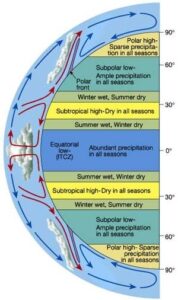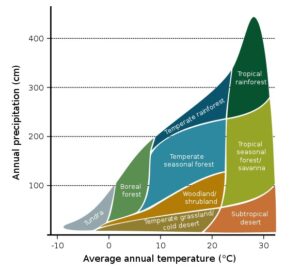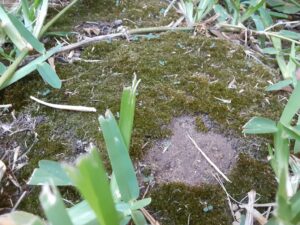Abstract:
Place matters; it makes a difference to who you are. Biogeography is the study of place and why organisms live where they do. Alexander Humboldt (1769 – 1859) was one of the first to introduce this to science and popular culture of his time. His curiosity about the natural world and ability to communicate with different audiences is still needed today. Temperature and moisture largely determine what species live in an area, but factors of latitude, proximity to large bodies of water, fire, herbivory and altitude are also important. Hot temperatures with little water create climates where unique success strategies are demonstrated. These strategies are also present in the human social interactions and personal behaviors. Where and how we live determines who we are. As we recognize the life and wonder in the place where we are, we learn about ourselves and our fellow species living with us. We can celebrate and care for wherever we are. Recognizing the importance of our place or location and its relationship to ourselves will make us better stewards of our world and ourselves.
Keywords: biogeography, Humboldt, biophilia, biome, microclimate, water
Place matters; it makes a difference to who you are. Biogeography is the study of place and why organisms live where they do. Many things determine where organisms live: water, temperature, dispersal, survival, competition and disturbance. Alexander Humboldt (1769 – 1859) was one of the first to introduce this to science and popular culture of his time. Humboldt traveled extensively in the Americas and took scientific measurements and records of everything he came across it seems. He received permission from the Spanish court to access all the land under their jurisdiction at the time. Simon Bolivar, one of the liberators of South America from Spain, called him the true discoverer of America. Most things with the name Humboldt attached are because of him, from Humboldt County, Iowa, USA to the Humboldt Current off the west coast of South America. Everywhere he went he meticulously documented the connection between the physical location and the living species. He was broadly knowledgeable about many sciences and recognized their interdependency.

Humboldt measured and marked where temperature changed across areas creating temperature maps. He did the same thing with moisture. These two vital components, temperature and water, create climate. Physical location determines climate, which consists of long-term weather, temperature and moisture. How hot or cold does it get? How wet does it get? Are there regular patterns of hot or cold? Wet and dry? Some general patterns can be determined. These patterns of temperature and moisture are called climate.
One of the primary factors determining temperature and moisture patterns is air movement and the sun. Of course, they are related. The equator and tropics receive the most direct sun all year round. The warm air rises picking up moisture. Warm air can hold more water than cold air. Warm air is more spread out and has space for lots of water molecules. This warm wet air rises in the tropics and cools as it does. The newly cool air is denser and cannot hold all that water, and so it rains, particularly in the tropics, where it is near constant. (Nairobi Kenya 1.2921° S, 36.8219° E; 869mm precipitation) The warm wet climate fuels all the photosynthesis and growth of the tropical rain forests. This type of climate also fuels the high diversity of all living species in the tropics, where the rainforests have the highest biodiversity of terrestrial or land ecosystems. In the water, it is coral reefs.

This newly dry air high above the tropics moves towards the poles in both directions and falls around 30° lat N and S. These are dry hot places. The great deserts of the world are located here (Cairo, Egypt 30.0444° N, 31.2357° E; 18mm precipitation). Warm rising air at 0° lat and dry falling air at 30° lat is a unit of air movement called a Hadley cell. The pattern repeats itself at 60° lat with rising moist air. The regular consistent moisture fuels the growth of the evergreen conifer forests (taiga and boreal) across Canada, northern Europe, Russia and China. The pattern continues with falling dry air at 90° lat. Place on the globe matters in large-scale air and moisture patterns; it largely determines the heat and moisture available for life.

In addition to latitude, the tilt of the earth gives us the seasonal changes throughout the year. The closer the location is to the poles N and S, the more dramatic the seasonal changes. In the summer on either hemisphere, the earth points toward the sun receiving more direct sunlight than in winter months. At the poles in summer, there is light all day long. The opposite is true in winter. The closer to the equator, the more similar the seasons are year-round.
In addition, closeness to large bodies of water (ocean or lake) and altitude affect local climate. Water changes temperature very slowly, and so locations close to the ocean do not experience the temperature extremes that landlocked locations do. Seattle USA (47.6062° N, 122.3321° W; 23°C high, 5°C low) is next to the Pacific Ocean and has a 20°C temperature range. Bismarck USA USA (46.825905° N, 100.778275° W; 30°C high, -15°C low) has a similar latitude but its landlocked location gives it a temperature range of 45°C. Increases in altitude means cooler temperatures and less water loss. Moving up a mountain there are regular changes in species from broadleaved deciduous mixed forest to evergreen conifer forests to bare rock past tree line if the peak is high enough.
I live in the 30° area with the falling dry air. (Odessa TX USA 31.845682° N, 102.367645° W; 373mm precipitation) In general, there is denial that this area is a desert. It does depend on how one defines desert. On average, Odessa has over 300mm of precipitation annually. That is a bit more than the 200mm high for most desert definitions. Definitely arid here though, maybe just the edge or neighboring the Chihuahua desert of North America is how we could define this area. The first time we had local water restrictions of any kind was recently with a serious regional drought. 2011 was a strong La Niña year with warm dry weather extremes in the southwest of the USA. The drought In Texas started in 2010 and ended summer of 2015. 2011 was the worst year of the most recent drought. Denial of the dry arid native atmosphere regime is the norm, but landscaping with low water plants, rock and artificial turf has become more common.
So, I live in the dry of West Texas USA. What does that mean? Dry adapted plants give more resources to roots than shoots – roots over shoots. Root networks compete fiercely for available moisture. This is called resource allocation. Sending valuable metabolic energy resources to the most needed part of the organism in order for success. Different strategies work. A shallow, spread out network can gain access to any available moisture when it comes. This area is economically tied to the oil field, and the population fluctuates with oil prices. People come in and out for work temporarily without established social ties. They strongly connect with each other for the time that they are here in the same schools, neighborhoods, churches and communities.
Another successful strategy for water in dry areas is deep taproots. Deep taproots can gain moisture away for the dry top soil horizon or layer. In my city, there are old timers who have endured many cycles of the oil industry. They are flush with resources in the good times and are very generous. In the lean times, they are still here, and they dig deep. They are still generous and help each other to survive downtimes.
In the desert, often reproduction cycles with moisture, not the temperature, of the seasons. Ocotillo (Fouquieria splendens) put on leaves and bloom when it is wet, regardless of time of year. The common name for this plant, Devil’s coachwhip, could describe the dry prickly seemingly dead stalks when the water is low. These plants are native to Sonoran and Chihuahua deserts of North America (McDonald 2020). In the wet years, everything greens up. Wildflowers show up I did not expect. Everything feels lush and relaxed. There is a problem with all this abundant primary production in photosynthesis. There is a lot of plant growth in the wet years. When the dry years come, and they do (Mose and Philpott 2015); there is a lot of dry plant fuel for fires. Lightning strikes, not to mention all the other ignition sources, will start a grass fire that can easily get out of control with wind, heat, and no rain. 2011 was also the year of dramatic and dangerous fires in Ft. Davis in my region (Gabbert 2019). I do enjoy the wet years, but they are tempered by concern for coming dry times and fire possibility with more vegetation now dried and ready to burn.

I grew up in the eastern, wetter side of Texas. I do not miss it in general, but as I drive east, I feel my soul hydrate. When it rains, I often go to the porch or window just to watch it. I had never seen, experienced, or even known about dry lightning storms until moving to West Texas. The feeling of the moisture in the heavy air before rain is rare, and I notice it. Often though, it feels like rain, but it does not. Virga is common to see in the wide skies when it is stormy. Virga is rain that falls but evaporates before it reaches anything. It looks like wet, teasing tails dragged behind the storm clouds. Despite forecasts of rain, I do not believe it or expect it. I just enjoy it when it happens. I love the sound of rain. Rainstorms are often dramatic deluges, sometimes with hail. Awareness of rain and moisture has become a regular habit due to its scarcity. Now I have lived longer here, in a dry hot place, than anywhere else in my life. When I visit other places, the moisture of the area is one of the first things I notice and feel. Of course, skin, the largest organ, does respond all over the body to this, so there is a lot of sensing surface.
The importance of moisture and adaptations for it fascinate me. Microclimate changes in moisture create interesting small-scale differences. My neighbor’s air conditioning unit collects condensation and sits at the drip line for the house. Moss grows there. Moss in the wild and dry of west Texas! Resurrection ferns, though, are native in our area. These ferns brown and curl up most of the time. In a rainy time, the ferns quickly green up and stretch out. I can simulate this in a 3-hour lab period in my classes. I feel as though I do the same on rainy days; I green up and stretch out taking in as much moisture as possible.

Before I moved to west Texas, I had an art book at my house featuring West Texas. Pecos to Rio Grande: Interpretations of Far West Texas by Eighteen Artists. My favorite quote about the area by one artist is: “Some say it’s the “Land That God Forgot.” But stand a moment – very still – and you will feel his presence” (Collins 1983). I loved the drama of the images in this book. The openness of the landscape, the bigness of the sky and sunset, the dramatic clouds and the few human inhabitants. I have always been a fan of the underdog, the unseen, the overlooked and little noticed. Maybe because I felt that way in my life; not dramatic and not exciting. However, I felt intrinsically my importance and value. The love and support of my parents to me as a middle child despite the hectic and crazy of a large family fostered this sense of importance and value. I see the presence of the divine in the everyday and the mundane when I look for it and pay attention.
Of course, temperature and moisture cannot explain everything. There are some holes in Humboldt’s ability to predict by location what to expect in living organisms (Pausas and Bond 2018). One of the considerations is the importance of fire to many natural systems. The long term stability of unforested areas was seen, and sometimes still is, as an undesirable outcome. The idea that trees and a stable climax forest is the goal or the pristine condition is inaccurate currently and historically. Another consideration is plant eaters, herbivores, that can make a big difference to what exists or not in any given location. As human expansion changes the food web by eliminating top predators, the herbivore prey can increase and change the plant community. This change in the base of the food web changes the amount and kind of photosynthesizing organisms. The disappearance of large animals, megafauna, in geologic history had a dramatic effect on organism food web structure. Not everything can be explained by physical location.
Humboldt was endlessly curious in his travels and data collection. He used these experiences and information to publish and lecture widely. He was able to make science interesting and accessible to regular people without an academic or technical background (Schrodt et al. 2019). I imagine that nowadays Humboldt would have a popular science blog, podcast, Ted talks and documentaries. Ira Flatow, on NPR’s Science Friday, would interview him.
Curiosity about our world, local small scale and globally large scale, is needed to understand ourselves individually and our collective future on this planet. The ability to make data and scientific inquiry accessible to the public in meaningful ways is vital. I am optimistic about the future of humanity and our world. Young people, and the rest of us, will be able to look and understand our world and situation in ways that have never been imagined. This new vision will prepare humanity for needed changes and enable us to enact them.
Humboldt in the 19th century and E.O. Wilson in the 21st century both advocate for appreciation and love of nature and life; they used the terms naturphilosophie and biophilia respectively. Where and how we live determines who we are. As we recognize the life and wonder in the place where we are, we learn about ourselves and our fellow species living with us. We may not be able to change our DNA and become a different species. We may not be able to change our latitude or the tilt of the sun without moving somewhere else. However, we can control microclimate to our benefit. We can choose shade and a cool drink on a hot dry day. We can celebrate and care for wherever we are. Recognizing the importance of our place or location and its relationship to ourselves will make us better stewards of our world and ourselves.
BIBLIOGRAPHY:
“Average Monthly Temperature in Seattle (Washington State), United States of America (Celsius).” World Weather & Climate Information, weather-and-climate.com/average-monthly-min-max-Temperature,seattle,United-States-of-America.
Buchele, Mose, and Ben Philpott. “The Texas Drought’s Over, But The Texas Slow-Motion Water Crisis Is Not.” NPR, NPR, 2015, stateimpact.npr.org/texas/2015/07/24/texas-droughts-over-heres-the-bad-news/.
“Climate and Average Monthly Weather in Bismarck (North Dakota), United States of America.” World
Weather & Climate Information, weather-and-climate.com/average-monthly-Rainfall-Temperature-Sunshine,bismarck-north-dakota-us,United-States-of-America.
Collins, Finis F. Pecos to Rio Grande: Interpretations of Far West Texas by Eighteen Artists. Texas A & M University Press, 1983.
“Data.org.” Climate, en.climate-data.org/africa/kenya/nairobi/nairobi-541, 2020/.
“Data.org.” Climate, en.climate-data.org/africa/egypt/cairo-governorate/cairo-3392/, 2020.
Gabbert, Bill. “Update on Rockhouse Fire at Fort Davis, Texas; 23 Homes and 2 Businesses Destroyed.” Wildfire Today, 26 Aug. 2019, wildfiretoday.com/2011/04/12/update-on-rockhouse-fire-at-fort-davis-texas/.
Humboldt, Alexander von. De Distributione Geographica Plantarum Secundum Coeli Temperiem Et Altitudinem Montium: Prolegomena. Libraria Graeco-Latino-Germanica, 1817.
McDonald, Charlie. “U.S. Forest Service.” Forest Service Shield, www.fs.fed.us/wildflowers/plant-of-the-week/fouquieria_splendens.shtml, 2020.
Pausas, Juli G., and William J. Bond. “Humboldt and the Reinvention of Nature.” Journal of Ecology, vol. 107, no. 3, 2018, pp. 1031–1037., doi:10.1111/1365-2745.13109.
Schrodt, Franziska, et al. “Challenges and Opportunities for Biogeography—What Can We Still Learn from Von Humboldt?” Journal of Biogeography, vol. 46, no. 8, 2019, pp. 1631–1642., doi:10.1111/jbi.13616.
Perry, Irene H. “Moss by AC unit.” 2020 JPEG file
Perry, Irene H. “Ocotillo.” 2020 JPEG file
Pinzke, Kenneth G. Applications and Investigations in Earth Science. Pearson Education (Us), 2014.
“Weather Averages Odessa, Texas.” Temperature – Precipitation – Sunshine – Snowfall, www.usclimatedata.com/climate/odessa/texas/united-states/ustx2587.
Whitakker, Robert Hardings. Communities and Ecosystems. Macmillan, 1975.
Irene Perry is a Biology Lecturer at University of Texas Permian Basin, Odessa TX USA. Her background is in ecology. She loves to share the wonder of life and enjoys exploring.

